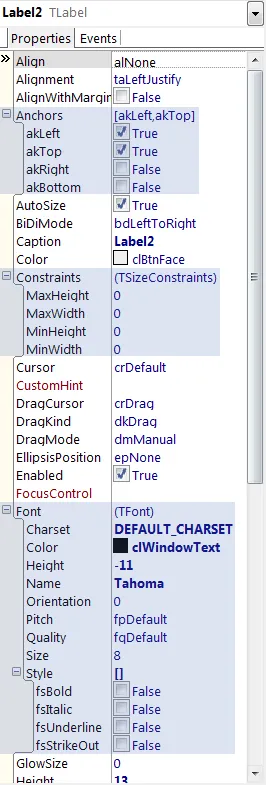概述
我知道之前已经有类似的问题被问过:
然而,我对于如何使用RTTI满足我的需求还没有进展。
我也花了很多时间和精力来撰写这个问题,所以希望它不会被关闭 :)
工作示例
下面有几个过程,可以将组件的属性名称、值和类型输出到TStrings列表中。原始源代码不是我的,我只做了一些小修改,整理了代码并将其放入一些方便重用的过程中:
以下内容将输出属性名称,例如:
- Color
- DoubleBuffered
- Enabled
- Height
- Width
procedure GetComponentPropertyNames(Component: TComponent; OutList: TStrings);
var
I: Integer;
Count, Size: Integer;
PropList: PPropList;
PropInfo: PPropInfo;
begin
OutList.BeginUpdate;
try
OutList.Clear;
Count := GetPropList(Component.ClassInfo, tkAny, nil);
Size := Count * SizeOf(Pointer);
GetMem(PropList, Size);
try
Count := GetPropList(Component.ClassInfo, tkAny, PropList);
for I := 0 to Count -1 do
begin
PropInfo := PropList^[I];
if not (PropInfo^.PropType^.Kind = tkMethod) then
begin
OutList.Add(PropInfo^.Name);
end;
end;
finally
FreeMem(PropList);
end;
finally
OutList.EndUpdate;
end;
end;
以下代码将输出属性值,例如:
- clWindow
- False
- True
- 25
- 75
function GetComponentPropertyValue(Component: TComponent; APropName: string): string;
var
I: Integer;
Count, Size: Integer;
PropList: PPropList;
PropInfo: PPropInfo;
begin
Count := GetPropList(Component.ClassInfo, tkAny, nil);
Size := Count * SizeOf(Pointer);
GetMem(PropList, Size);
try
Count := GetPropList(Component.ClassInfo, tkAny, PropList);
for I := 0 to Count -1 do
begin
PropInfo := PropList^[I];
if not (PropInfo^.PropType^.Kind = tkMethod) then
begin
if SameText(PropInfo^.Name, APropName) then
begin
Result := System.Variants.VarToStr(GetPropValue(Component, PropInfo^.Name));
Exit;
end;
end;
end;
finally
FreeMem(PropList);
end;
end;
procedure GetComponentPropertyValues(Component: TComponent; OutList: TStrings);
var
SL: TStringList;
I: Integer;
begin
SL := TStringList.Create;
try
GetComponentPropertyNames(Component, SL);
for I := 0 to SL.Count -1 do
begin
OutList.Add(GetComponentPropertyValue(Component, SL.Strings[I]));
end;
finally
SL.Free;
end;
end;
最后,下面的代码将以字符串格式输出属性类型,例如:
- TColor
- 布尔型
- 布尔型
- 整型
- 整型
function GetComponentPropertyType(Component: TComponent; APropName: string): string;
var
SL: TStringList;
I: Integer;
PropInfo: TPropInfo;
PropTypeName: string;
begin
SL := TStringList.Create;
try
GetComponentPropertyNames(Component, SL);
for I := 0 to SL.Count -1 do
begin
PropInfo := GetPropInfo(Component, SL.Strings[I])^;
if SameText(PropInfo.Name, APropName) then
begin
PropTypeName := PropInfo.PropType^.Name;
Result := PropTypeName;
Exit;
end;
end;
finally
SL.Free;
end;
end;
procedure GetComponentPropertyTypes(Component: TComponent; OutList: TStrings);
var
SL: TStringList;
I: Integer;
begin
SL := TStringList.Create;
try
GetComponentPropertyNames(Component, SL);
for I := 0 to SL.Count -1 do
begin
OutList.Add(GetComponentPropertyType(Component, SL.Strings[I]));
end;
finally
SL.Free;
end;
end;
每个过程的输出并排摆放,效果如下:
- 颜色 | clWindow | TColor
- DoubleBuffered | False | 布尔型
- 启用 | True | 布尔型
- 高度 | 25 | 整数
- 宽度 | 75 | 整数
问题
目前所有的内容都能正常运行,没有任何问题,除了我需要花一些时间阅读文档来更好地理解并消化这些内容。
我的问题(已经困扰我几天了)是如何正确获取和设置子属性。例如,请看这张 Delphi 对象检查器的截图(为说明修改):

就像之前显示的那些过程一样,我需要在这些被我标记为蓝色的子属性上做相同的事情。
理想情况下,我希望有一个函数,可以传入一个组件和一个属性名,并返回 True 如果它有子属性,所以大概像这样:
function HasSubProperty(Component: TComponent; APropName: string): Boolean;
begin
Result := ??
end;
我不确定这种方法是否有效,如截图所示,某些子属性也有子属性(例如Component>Font>Style)。
最终我想要的是一种检索子属性名称、值和类型的方法。类似于:
procedure GetComponentSubPropertyNames(Component: TComponent; APropName: string;
OutList: TStrings);
begin
//
end;
当被调用时:
GetComponentSubPropertyNames(Label1, Anchors);
应该检索:
- akLeft
- akTop
- akRight
- akBottom
类似的程序来获取值和类型的方法如下:
- akLeft | True | Boolean
- akTop | True | Boolean
- akRight | True | Boolean
- akBottom | True | Boolean
对于字体子属性,例如:
- Charset | DEFAULT_CHARSET | TFontCharset
- Color | clWindowText | TColor
- Height | -11 | Integer
- Orientation | 0 | Integer
- Pitch | fpDefault | TFontPitch
- Quality | fqDefault | TFontQuality
- Size | 8 | Integer
要访问另一个子属性 (Font.Style),则需要使用以下程序:
procedure GetComponentSubPropertySubPropertyNames(Component: TComponent; APropName, ASubPropName: string; OutList: TStrings);
begin
//
end;
这就变得有些愚蠢了。
摘要
基本上我需要一种方法来深入挖掘属性的更深层级,获取它们的名称、值和类型,并将它们放入列表中,还能够更改这些值。
如果有人可以编写一些代码示例,以展示如何实现这一点(最好在代码中添加一些注释),我会非常感激。对于某些人来说,这可能是一个相对容易的任务,但我确实发现这非常琐碎。
到目前为止,阅读各种文档和示例仍然让我感到相当困惑,主要问题是不知道应该使用哪些类型或如何正确地创建和管理它们。
HasSubProperty看起来工作正常,实际上我认为我应该更好地命名它为HasSubProperties,但这是一个快速的更改。PropInfo := GetPropInfo(Component, APropName);总是返回 nil 并在使用GetSubPropClass函数时抛出 AV 错误。你的 Button1 事件中也有一个小错别字,应该是GetComponentPropertyNames(GetSubPropClass(Form1,'TFont'), ListBox4.Items);而不是GetComponentPropertyNames(GetSubPropClass(Form1,'TFont',ListBox4.Items);:) - CraigFont而不是TFont时才有效,例如传递Margins时它也能正常工作,但是当传递Anchors甚至StyleElements时就会失败。 - Craig